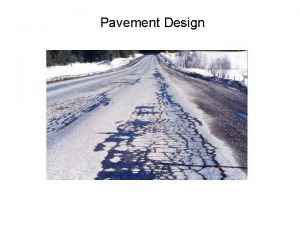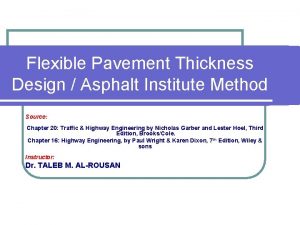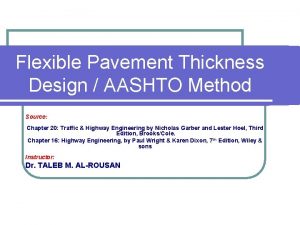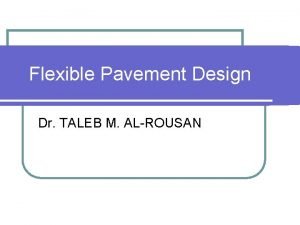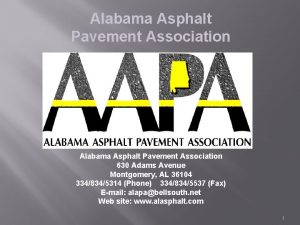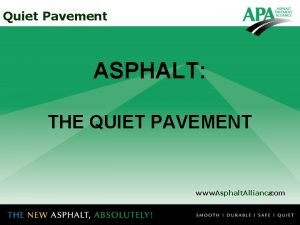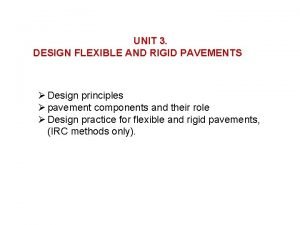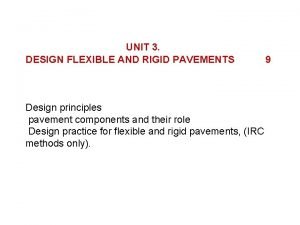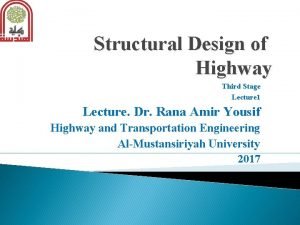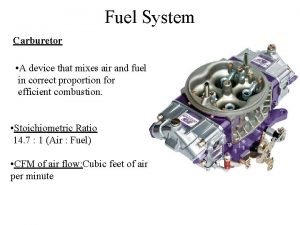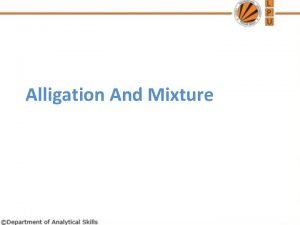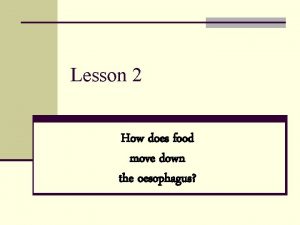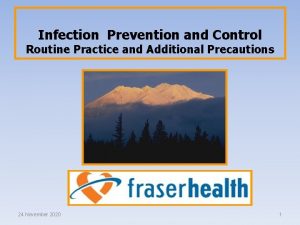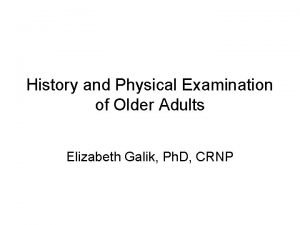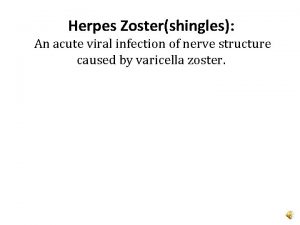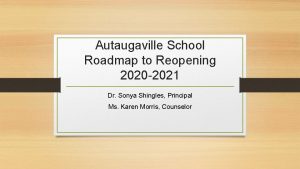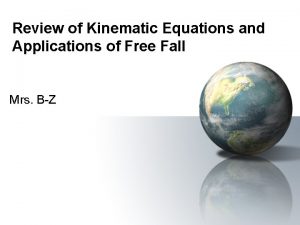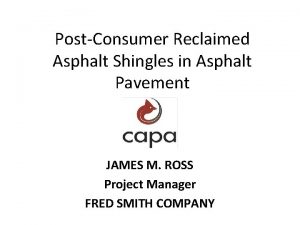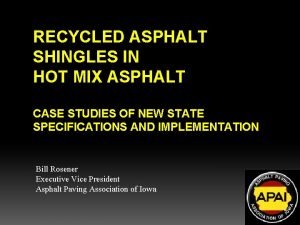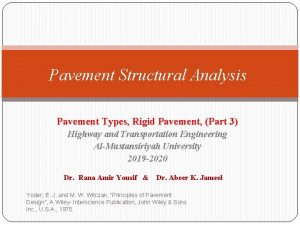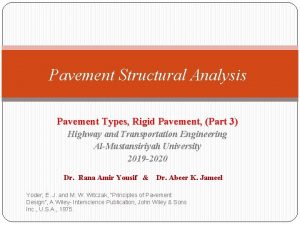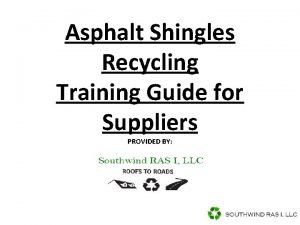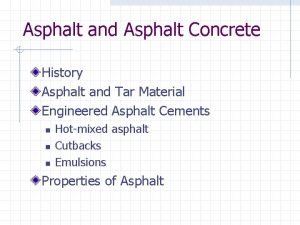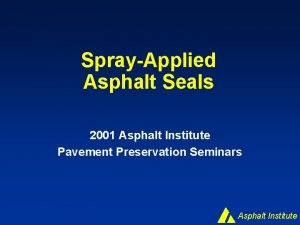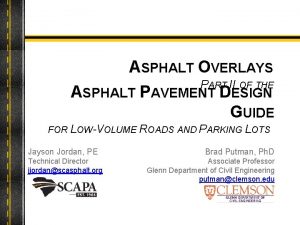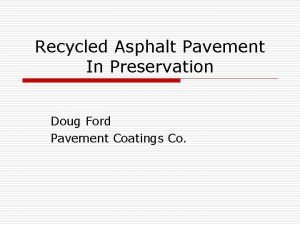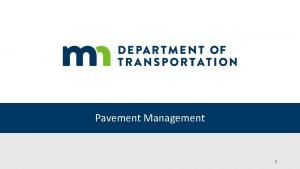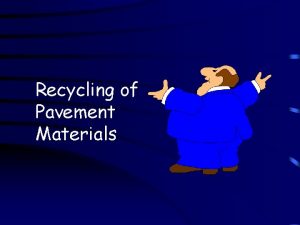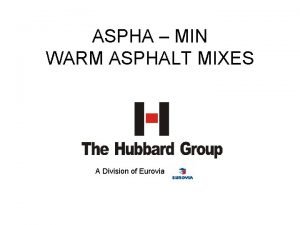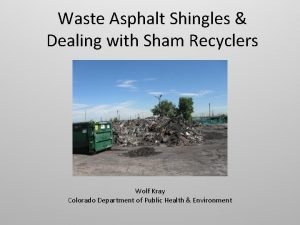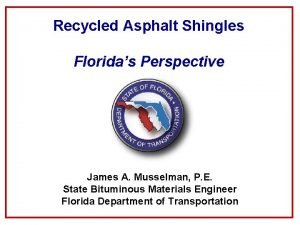ANALYSIS OF RECYCLING ASPHALT SHINGLES IN PAVEMENT MIXES

























- Slides: 25

ANALYSIS OF RECYCLING ASPHALT SHINGLES IN PAVEMENT MIXES FROM A LIFE CYCLE PERSPECTIVE KENDRA A. MORRISON, U. S. EPA REGION 8

WHY WAS THE STUDY CONDUCTED? • Support the Colorado Roofs to Roads Initiative: http: //www. roofs 2 roadscolorado. org/ • Growing interests in EPA Region 8: CO, MT, ND, SD, UT, and WY • Look at environmental benefits from recycling more holistically • What we expect: • Conservation of natural resources • Save landfill space • Decrease emissions of greenhouse gases (GHGs) and other releases/impacts • Energy savings 2

LIFE CYCLE ASSESSMENT (LCA) BASED STUDY • Environmental life cycle assessment is a quantitative accounting of the cumulative environmental impacts of a product or process across all stages of the life cycle Renew Recycle Energy, Water Inputs Resource Extraction Material Processing Remanufacture Energy, Water Inputs Reuse Energy, Water Inputs Product Design and Manufacturing Product Use Composting Energy, Water Inputs Collection/ Processing Energy, Water Inputs Disposal Transportation Emissions to Air, Water, and Land 3

WHAT WAS THE GOAL? • GOAL: To compare limited environmental inventory and impacts of seven (7) asphalt mixes with various percentages of reclaimed asphalt and recycled shingles to a baseline of virgin asphalt EPA’s analysis is only an initial, limited life cycle inventory and impact assessment 4

ABOUT REPORT AND KEY CONTENT • Considers recovered materials and innovative technologies used in asphalt production • Used regional characterization factors, where possible: (e. g. mix designs and distances to obtain materials and to transport pavement to the construction site) • Inventory and impacts examined from material extraction to transport to the construction site: • Avoided landfill impacts • Greenhouse gas (GHG) emissions/Global Warming Potential (GWP) • Criteria and other air pollutants • Energy consumption and resource depletion are considered only for select stages in the life cycle 5

SCOPE AND PROCESS DESCRIPTION 6

WHERE WAS THE DATA COLLECTED FROM? • Local asphalt producers – energy and materials, mix designs • National Renewable Energy Laboratory’s U. S. Life Cycle Inventory Database – fuels, electricity, transportation, equipment and process emissions • National Institute of Standards and Technology’s Building for Environmental and Economic Sustainability (BEES) tool – sand aggregate data • EPA’s Waste Reduction Model (Wa. RM) – GHG savings information • Intergovernmental Panel on Climate Change (IPCC) – global warming potentials 7

MIX SCENARIOS Scenario Type of Mix 1 HMA Virgin Materials Virgin 2 HMA Hot Mixed Reclaimed Asphalt Pavement (20%) 20% RAP WMA Warm Mixed Reclaimed Asphalt Pavement (20%) WMA 20% RAP HMA 20% Reclaimed Asphalt Pavement and 3% Recycled Asphalt Shingles 20% RAP-3% RAS HMA 20% Reclaimed Asphalt Pavement and 5% Recycled Asphalt Shingles 20% RAP-5% RAS HMA 20% Reclaimed Asphalt Pavement and 7% Recycled Asphalt Shingles 20% RAP-7% RAS HMA 17% Reclaimed Asphalt Pavement and 3% Recycled Asphalt Shingles 17% RAP-3% RAS HMA 5% Recycled Asphalt Shingles 5% RAS 3 4 5 6 7 8 Design Mix Referred To As 8

SOME KEY ASSUMPTIONS • Virgin aggregate is transported 36 miles, while recycled materials are transported 9 miles. • Transportation to the construction site is 30 miles for all asphalt mixes except WMA 20% RAP, which is assumed to be transported 60 miles. • RAP contains 4% binder and RAS contains 24. 3% binder by weight. • All mixes require binder from the petroleum refiners, have the aggregates heated using natural gas, and are mixed in a drum plant. • The physical activities associated with placing, maintaining, and removing of the pavements, as well as the emissions from those activities, are assumed to be similar across all scenarios. • All asphalt mixes are able to perform under the road conditions for which they are designed. 9

RESULTS All results are reported with respect to the production of 1 short ton of asphalt transported to a road construction site. 10

ENERGY USE Energy Consumption During Select Life Cycle Stages WMA 20% RAP = 12% energy reduction vs. HMA 20% RAP mix 11

RESOURCE DEPLETION Quantities of Virgin and Recycled Aggregates Virgin Quantity (lb/short ton) Recycled Quantity (lb/short ton) Virgin 1, 881 - 20% RAP 1, 514 383 WMA 20% RAP 1, 514 383 20% RAP-3% RAS 1, 467 444 20% RAP-5% RAS 1, 436 485 20% RAP-7% RAS 1, 404 527 17% RAP-3% RAS 1, 523 386 5% RAS 1, 809 96 Scenario 12

AVOIDED LANDFILL IMPACTS Mass and Volume Reductions from Recycling RAS and RAP Mass Avoided (lbs/short ton) Volume Avoided (cubic yards/short ton) 0 0 20% RAP 383 0. 28 WMA 20% RAP 383 0. 28 20% RAP-3% RAS 444 0. 42 20% RAP-5% RAS 485 0. 52 20% RAP-7% RAS 527 0. 62 17% RAP-3% RAS 386 0. 38 5% RAS 96 0. 23 Scenario Virgin 13

GREENHOUSE GAS CREDIT FOR AVOIDED LANDFILL 14

GREENHOUSE EMISSIONS • When transportation to the construction site is assumed to be 30 miles for all asphalt mixes, there is a 3% reduction in GHGs when switching from the 20% RAP to the WMA 20% RAP. • When transportation to the construction site is assumed to be 60 miles for the WMA 20% RAP (30 miles for all other mixes), the WMA 20% RAP GHG emissions are 9% higher. 15

GLOBAL WARMING POTENTIAL 16

GLOBAL WARMING POTENTIAL Change (lbs CO₂e/short ton) With no Landfill Credit With Landfill Credit 20% RAP WMA 20% RAP, 3% RAS 20% RAP, 5% RAS 20% RAP, 7% RAS 17% RAP, 3% RAS 5% RAS -8. 1 5. 8 -16. 8 -21. 6 -26. 6 -16. 9 -10. 4 -5% 4% -10% -13% -16% -10% -6% -23. 0 -9. 1 -34. 0 -40. 4 -47. 0 -31. 9 -14. 2 -14% -6% -21% -25% -29% -19% -9% = mix with greatest reduction = RAS mixes meeting CDOT specification 17

CRITERIA AND OTHER AIR POLLUTANTS 18

AIR POLLUTANTS BY PROCESS FOR 20% RAP-5% RAS MIX 19

CONCLUSIONS • There are environmental benefits to the use of recycled asphalt shingles (RAS) in asphalt production for use in road construction. • Larger reductions in impacts are seen when RAP is included over solely using RAS. The addition of RAP reduces the amount of virgin aggregate required which must be transported over a longer distance. • Combining RAP and RAS diverts even larger volumes of material away from landfills, and these amounts are quantified in the study. 20

CONCLUSIONS Decreasing GWP as RAS Content Increases in HMA mixes • The addition of RAS to pavement mixes that use RAP helps further increase environmental reductions relative to the baseline of using virgin asphalt. 160 Global Warming Potential (lbs CO₂e/short ton) 140 120 100 80 60 40 20 0 0% 1% 2% 3% 4% 5% 6% 7% 21

CONCLUSIONS • Transport distances for aggregate and asphalt are both highly sensitive variables that can have large impacts on the total life cycle emissions. Aggregate Production Asphalt Plant • Loader Roadway Construction transportation distance for WMA from 30 to 60 miles raises the GHG emissions for transportation by 51% compared to the equivalent HMA case. The change is 19 lbs CO 2 e/short ton of asphalt, which is over 10% of the emissions considered in the study. 22

GOING FORWARD WITH RAS • Asphalt shingles (and asphalt pavement) are 100% recyclable. • Recycling saves landfill space • Emissions of GHGs associated with operation and transportation to the landfill are avoided • Upstream impacts from aggregate processing are mitigated • Conservation of natural resources • Reduction of environmental pollution from material extraction and processing • GHG and other air emissions from transport are reduced due to less fuel consumption • Valuable oil is reused and upstream air emissions are reduced • Win / win when used responsibly 23

WHO CONTRIBUTED TO THE PEER REVIEWED REPORT? • Peer consultation during development: • Jarrett Welch – Brannon Sand & Gravel Co. • Gary Stillmunkes – Asphalt Specialties Company Inc. • William Turley – Construction Demolition & Recycling Association • Dr. Howard Marks – National Asphalt Pavement Association • Dr. Audrey Copeland – National Asphalt Pavement Association • Peer reviewers of draft final report: • Dr. Maryann Curran – U. S. EPA Office of Research and Development • Marie Zanowick – U. S. EPA Region 8 • Dr. Alberta Carpenter – National Renewable Energy Laboratory • Dr. Arunprakash Karunanithi – University of Colorado Denver • Victor (Lee) Gallivan – Federal Highway Administration 24

CONTACT INFORMATION AND REPORT Kendra A. Morrison U. S. EPA Region 8 (303)312 -6145 morrison. kendra@epa. gov Report can be obtained from EPA Region 8’s website: http: //www 2. epa. gov/region 8/industrial-materialsrecycling Construction Demolition & Recycling Association (2013). C&D World. September/October, 6(5): 14 -25. 25
 Asphalt pavement design example
Asphalt pavement design example Asphalt pavement design example
Asphalt pavement design example Asphalt pavement thickness design
Asphalt pavement thickness design Aashto method of flexible pavement design
Aashto method of flexible pavement design Asphalt pavement design example
Asphalt pavement design example Alabama asphalt pavement association
Alabama asphalt pavement association Quiet pavement
Quiet pavement Flexible pavement
Flexible pavement Standard axle load for pavement design
Standard axle load for pavement design Compare flexible and rigid pavement
Compare flexible and rigid pavement Device which mixes air and fuel
Device which mixes air and fuel A merchant mixes three varieties of wheat costing
A merchant mixes three varieties of wheat costing A trader mixes 26 kg of rice
A trader mixes 26 kg of rice Zahra mixes 150g of metal a
Zahra mixes 150g of metal a A muscular bag secretes gastric juice
A muscular bag secretes gastric juice White light mixes
White light mixes Shingles medscape
Shingles medscape K-shingles examples
K-shingles examples Shingles vaccine side effects
Shingles vaccine side effects Shingles precautions
Shingles precautions Physical examination conclusion
Physical examination conclusion Vagus nerve shingles
Vagus nerve shingles Luke autbeloe drops a pile of roof shingles
Luke autbeloe drops a pile of roof shingles Sonya shingles
Sonya shingles Luke autbeloe drops a pile of roof shingles
Luke autbeloe drops a pile of roof shingles Shingles and pomalidimide
Shingles and pomalidimide

